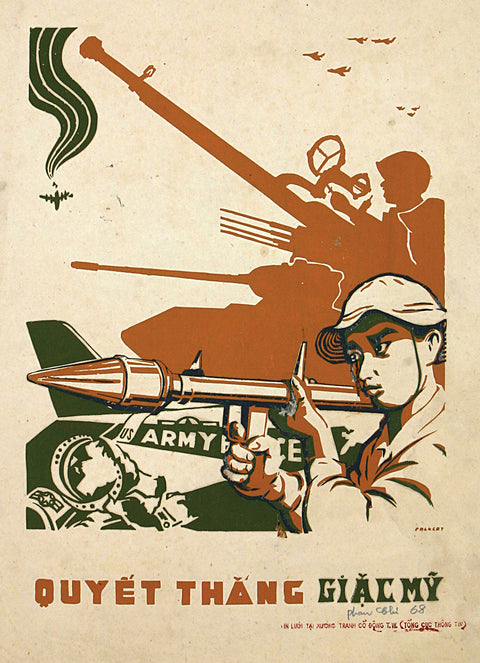
During the Vietnam War, These Colorful Posters Aimed to Win Hearts and Minds
The word “propaganda” evokes many images, few of them positive. We often think of propaganda as sinister attempts to brainwash a population into embracing authoritarian political systems, with posters typically part of the effort. History has shown that it’s indeed easy for propaganda to turn ugly—governments have long utilized it to indoctrinate a population to act in ways that it normally would not, and to demonize people and views. Nazi Germany’s vilification of Jews is an obvious example.
But propaganda is often more subtle and can often be attempts to simply inspire and promote the shared values and objectives of the community. Take Uncle Sam “wanting you” to defend America during World War I, Britain’s “Keep Calm” posters of the Second World War, and the strength behind the let’s-all- pitch-in message of Rosie the Riveter.
Propaganda from North And South
The ongoing conflicts in Southeast Asia—from the French Indochina wars beginning in the late 1940s through the U.S. withdrawal in 1975—was a classic case where winning over the population was half the battle. At its heart, the Vietnam War was a civil war.
Here are a series of posters, many quite rare, extolling the virtues of both the communist North and the democratic South—all efforts to win the hearts and minds of the people of Vietnam. Poster art had a long tradition in Vietnam. Because 80% of the population was still illiterate as of 1945, the power of imagery was critical in promoting viewpoints, conveying ideas, and inspiring people to action.
For the North, the artists’ message often tried appealing to the population’s sense of community and country, while also attempting to recruit solders for the fight. Meanwhile, the South tended to focus on rallying the population to fend off the wider specter of communist aggression—a focus encouraged by the United States. By 1969, the U.S. had produced more than 23 million propaganda posters and pamphlets for South Vietnam .
A 1954 poster created for South Vietnam by the U.S.
Information Agency warns that: “Anywhere there is communism, there is
terrorism and assass-ination.”
A 1964 South Vietnamese recruitment poster—with text
proclaiming that “The Army is Your Future”—advertises the skills soldiers
could learn in the ARVN.
Ho Chi Minh’s legacy lived on
long after his 1969 death. This 1980 poster celebrates the man revered as the
father of the country’s communist revolution. The poster reads, “Nobody loves
Uncle Ho as children do, nobody loves children as Uncle Ho does.”
A 1975 North Vietnamese poster
features an ethnic-minority woman with a machine gun over her shoulder. The
North tried to emphasize that all of Vietnam’s many ethnic groups were
included in their vaunted national fight against imperialism.
In 1953, a 20-year-old peasant girl named Tran Thi
Tam led a guerrilla team of seven women on a mission against the French. Her
spirit is shown here floating above a female solider, encouraging her and
other women to fight.
Women were often depicted in
Vietnamese propaganda posters. Here a female Viet Cong fighter stands ready;
behind her the split red and blue colors of the VC flag represent the division
within Vietnam.
1968’s Tet Offensive
inspired this North Vietnamese battle poster. One of the captions reads,
“Sweep clean the American enemy aggressors.”
this article first appeared in vietnam magazine
As part of the
effort to shape worldwide public opinion, the U.S. Information Agency in 1965
produced a policy paper and an affiliated poster outlining the North’s “brutal
campaign of terror and subversion against a peaceful nation.”
Another U.S.-made
poster counseled that ARVN soldiers “must be close to the people, protect the
people and help the people.” U.S. Army advisers frequently had to remind their
South Vietnamese counterparts to be courteous to the local population, taking
care, for example, to ensure their tanks didn’t run over farmers’ chickens.
An early warning of the communist threat is shown in this 1951
poster made during the French Indochina War showing representations of China,
the Soviet Union, and North Vietnam attacking the South.
A South Vietnamese
propaganda leaflet promotes Strategic Hamlets, fortified villages set up in
the countryside to fight communists. The pamphlet explains that, in these
hamlets, the “whole population actively participates in guerrilla warfare.”
This call to arms implores Southern peasants to
“Destroy the Viet-Minh,” and shows the slashing of North Vietnam’s flag.
This same North
Vietnamese flag is proudly held up by a Northern woman encouraging
agricultural development: “Raise pigs to be strong, to guide the growth of new
paddies and the planting of tea.”
This story appeared in the 2024 Winter issue of Vietnam magazine.
historynet magazines
Our 9 best-selling history titles feature in-depth storytelling and iconic imagery to engage and inform on the people, the wars, and the events that shaped America and the world.
